This house has three Pillars
September 16, 2016 11:45 am | Posted in Features | Share now TwitterFacebook
Vanuatu’s new strategic plan presents an inclusive vision for development. But is it too inclusive?
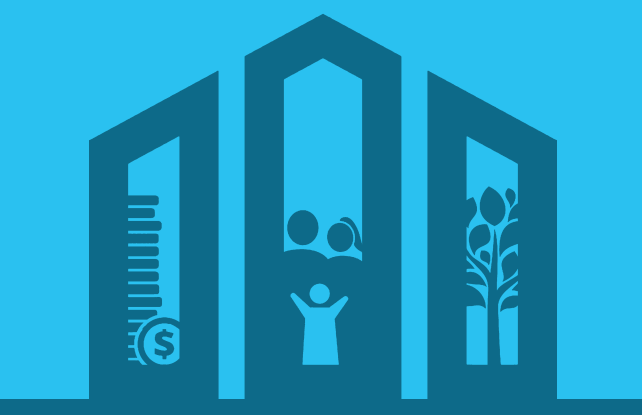
In October of 2013, a high-level gathering occurred that now seems set to define the progress of the nation for a generation.
At the Farea Pasifika in Mele village just outside of Port Vila. Hundreds gathered to participate in the inaugural stages of what has become the National Sustainable Development Plan. Lands minister Ralph Regenvanu and then-Director of Strategic Planning Benjamin Shing led the session.
This meeting marked a departure from past planning processes. The structural readjustment approached of the much maligned Comprehensive Reform Plan, instituted in the late 1990s largely due to pressure from the ADB, had long since fallen by the wayside. But its successor, the Priority Action Agenda, still resembled in the CRP in that it was primarily a financial management plan.
Introduced in 2006 and updated periodically, the plan called for a “Just, Educated, Healthy and Wealthy Vanuatu”. But financial and economic management provided five of out seven toplevel priorities, and the remaining two—education and health—were largely expressed in economic terms.
This time, due largely to the intercession of the International Union on the Conservation of Nature, or IUCN, and the Green Growth initiative, we were about to change the way we talked about development.
Broadening the base
At the core of this new vision was a desire to move away from viewing our challenges and ambitions through the single lens of finance.
In the preface of the National Sustainable Development Plan is the image of a narrow pyramid in which progress is measured entirely in financial terms. Instead of a single bottom line, the plan argues for what’s known as a Triple Bottom Line. “The phrase…” writes The Economist, “was first coined in 1994 by John Elkington, the founder of a British consultancy called SustainAbility. His argument was that companies should be preparing three different (and quite separate) bottom lines.
One is the traditional measure of corporate profit—the ‘bottom line’ of the profit and loss account. The second is the bottom line of a company’s ‘people account’— a measure in some shape or form of how socially responsible an organisation has been throughout its operations. The third is the bottom line of the company’s ‘planet’ account—a measure of how environmentally responsible it has been. The triple bottom line (TBL) thus consists of three Ps: profit, people and planet.”
Rebalancing of Sustainable Development Pillars
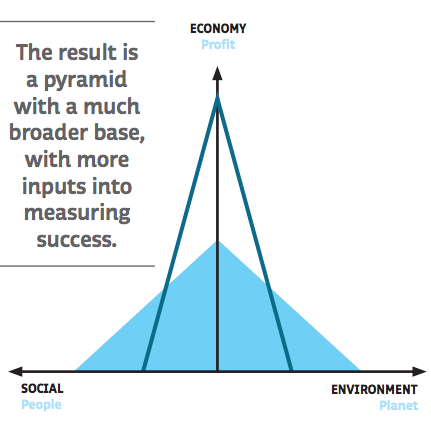
The result is a pyramid with a much broader base, with more inputs into measuring success.
From Torres to Aneityum
The Daily Post wrote, “In his Independence Day address, Prime Minister Charlot Salwai stated his government’s commitment to ensuring that the National Sustainable Development Plan, or NSDP, was one that was owned by the people.
“Describing a consultation process that reached communities from Aneityum to the Torres islands, he announced that ‘this is the first time that Government is consulting with communities in its national development plans.’”
In all, the staff of the Department of Strategic Policy, Planning and Aid Coordination—known as DSSPAC and pronounced DESS-pak— conducted in-depth discussions with nearly 1500 people from one end of the country to the other.
The process was simple but comprehensive: Staffers and consultants put together the broad strokes of what they felt were the national priorities in each of the three pillars of Profit, People and Planet. They presented these to the people as checklists with a write-in option. Participants could tick the box if they agreed with the item, cross it off if they didn’t see it as a priority, or they could write in additional options if they thought something was missing.
“During that exercise,” the Daily Post reported, “they built a list of national priorities that comprised all of the themes and issues raised during the consultation process. They added a ‘very, very few’ items at that stage, and the document that resulted is being finalised as our policy compass from here to 2030.”
A broad foundation
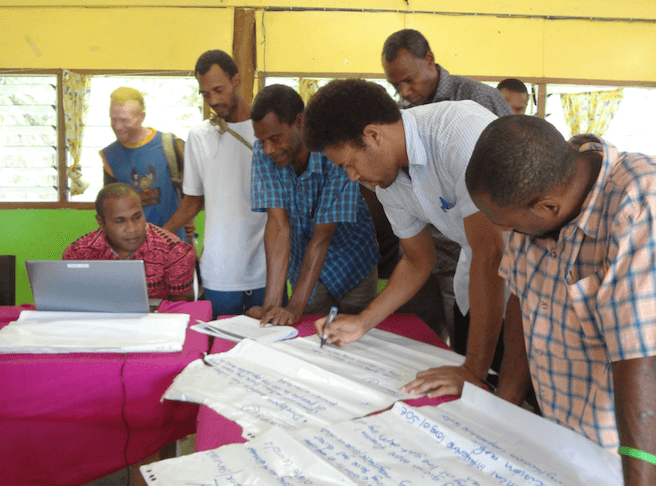
Underlying the entire structure of the NSDP is Vanuatu’s richest resource—its culture.
A late draft of the plan reads, “Culture is a representation of the underlying Melanesian Values of Respect, Harmony, Unity and Forgiveness.”
This assertion marks a fundamental departure from previous planning philosophies. In spite of the presence of culture in the preamble of the Constitution, in spite of endless rhetoric on the campaign trail, in conference rooms and elsewhere, basic Melanesian values were often absent in planning documents that did more to reflect free market principles and individualism than the more collectivist stance that exists in every village, indeed in every family.
We were wrong not to include them before. Writing them out of the plan couldn’t make them go away.

The people pillar
The NSDP states, “Development has to be about culture, identity, families, communities and society. It has to be about Vanuatu. The culture and society of Vanuatu is the country’s strength. The traditional family is the only social safety net for most of the young, the old and the disadvantaged in the country.”
At the highest level, this Society section of the plan sets traditional governance, Christian principles and related moral stances as the framework within which the conversation will occur. This includes language and locale preservation, traditional medicine, cultural education and sustaining elements of the traditional economy.
Inclusiveness provides two goals, the first of which touches primarily on ensuring access to education, providing alternative pathways to success, including vocational training. Another provides and promotes protection for ‘women, youth, vulnerable groups and the elderly’. This includes occupational health and safety provisions.
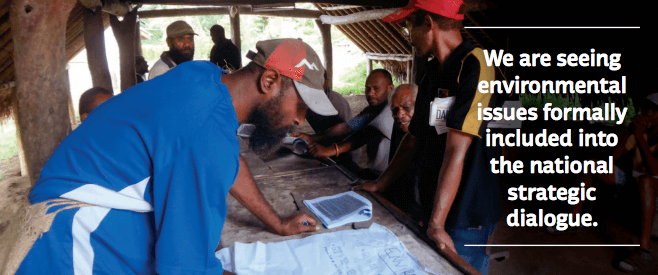
A third goal joins physical health objectives with broader objectives such as healthy lifestyles. Given the prevalence of NCDs and their almost incalculable opportunity cost at the national level, the brevity of this statement belies its importance.
Goal number five deals with rule of law, calling for timely access to justice, improved military, police and border protection services, as well as a continued effort in reconciling kastom and the law.
The final social goal calls for strengthening of the public sector. While most will see this through the prism of improved efficiency and a renewed culture of professionalism, there is also language against politicisation and corruption. (See ‘The same old CR?P’, later in this issue.)
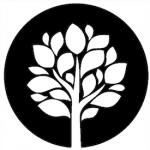
A plan for the planet
For the first time in Vanuatu—indeed, in the developing world—we are seeing environmental issues formally included into the national strategic dialogue. Entire schools of economic theory have emerged of late as businesses and government struggle to come to terms with the cost of resource extraction, industrial growth and technological development.
The NSDP addresses a number of goals and objectives in this arena, the most significant of which are an emphasis on low-impact industrial practices and technologies. Pursued properly, this strategy could result in a leaner and more profitable private sector.
Climate change looms large, of course. We are already coping with the effects of global climate change, evidenced by stronger cyclones and more pronounced climate events. Without formal engagement at all levels from local to global, our economy is sure to suffer increasingly damaging shocks.
Some of the conservation-related goals will no doubt be put to the test in the face of investment opportunities that come at a cost to the environment. Mineral resources and fisheries are specifically mentioned in the document, but it remains to be seen what action will eventuate.

Vouchsafing the Vatu
The economy has the fewest high-level objectives of the three pillars. But that doesn’t mean that it’s carrying less of the overall weight. The goals are more or less what one would expect: Stimulate trade, especially skills exports; continue building out infrastructure; extend the cash economy deeper into the islands; improve entrepreneurialism at home and from abroad.
If the past is any guide, these four high-level objectives will take up most of the oxygen in the room as policies are mooted and developed. It’s a simple fact that new policies require resources, and the only way to increase our resources is to increase our prosperity. Slicing a too-small pie differently might be fairer, but it’s not going to solve the hunger problem.
One worrying aspect of this strategy: the question of infrastructure finance gets only a single, oblique mention. This is one area in which the will of the people might need to be led to a broader understanding of the costs of their choices. The question of how to approach continued investment in infrastructure demands a strategic response, and a 15-year timeframe is not unreasonable for such a view. The plan is remiss in not dealing with it with more clarity.
No dragon, no princess
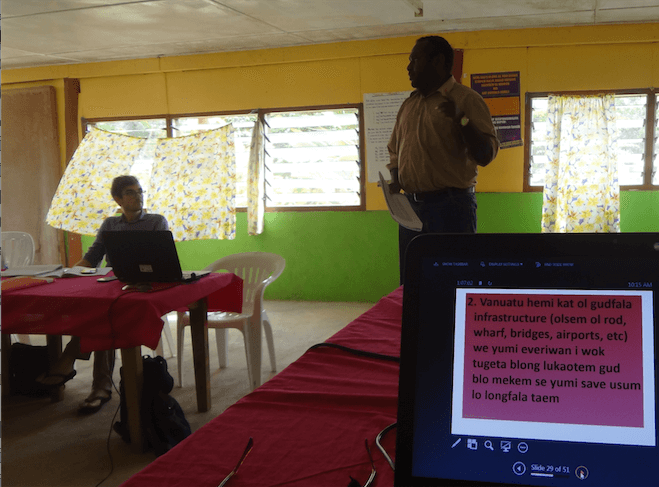
Presented with a plan such as the NSDP, a skeptic might ask, ‘Where’s the dragon?’
In the late 1990s, Komatsu, a Japanese heavy equipment manufacturer, revitalised itself through its nowlegendary mission statement: ‘Surround Caterpillar.’ The plan was simple: attack their competitor in every market outside of the continental United States. The staff and management rallied; they measured even daily progress in terms of whether they’d furthered the goal or not.
This kind of mission statement became known as Killing the Dragon—in a nutshell, find your greatest threat and defeat it.
More recently, companies have favoured a corollary approach: Saving the Princess—define your dream and strive every day toward it. When taken to its absurd, parochial limits, it is rightly lampooned in motivational posters and social media snark.
But there is no doubt that Vanuatu has lacked a unifying national vision since Walter Lini angrily split from his own party in 1991. The vision of the National Sustainable Development Plan is a positive one in many ways, but similar to the UN’s Sustainable Development Goals, it lacks a simple expression that will motivate and unify a people.
‘This is our nakamal’
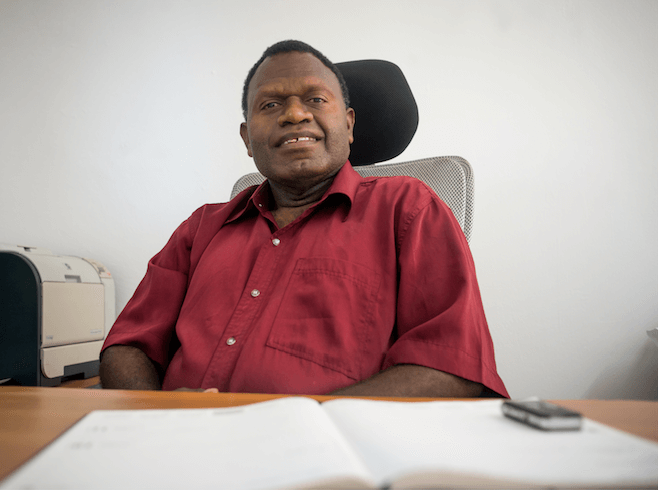
DSSPAC director Gregoire Nimbtik doesn’t see this as a problem. In an interview with the Vanuatu Business Review, he said that if the NSDP consists of three pillars, then it is the nakamal where our national development discussions will take place. He sees the plan not as a mission document, but rather as a map setting out the borders of the development debate.
The problem with an all-encompassing document such as this is that its cost implications are far from obvious. Planners are quick to protest that a document arching over a 15 year span cannot—in fact must not—be too detailed or too prescriptive. That’s all well and good, but nearly all of our biggest challenges are going to require some very specific and sustained strategies.
And every strategy comes with opportunity costs. Holistic approaches are useful when checking if we’ve overlooked anything, less so when setting priorities. Health, education and infrastructure development are all sectors that can have a decisive impact on the future of the country. While the NSDP works hard to ensure they are not left out of the debate, it’s fair to ask what it’s going to take to develop a clear vision of how to create actual health and education systems from the shambles we’ve inherited.
The NSDP does many things, and it is a commendable achievement for that. But it’s a cautious, sober document at a time when some would argue we need something more stirring.









